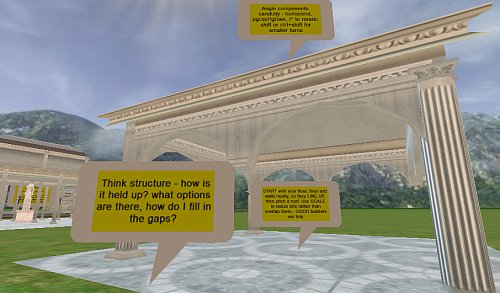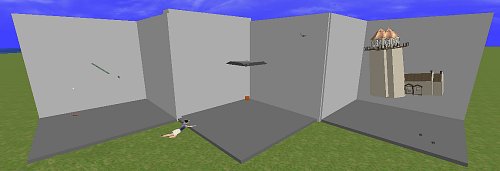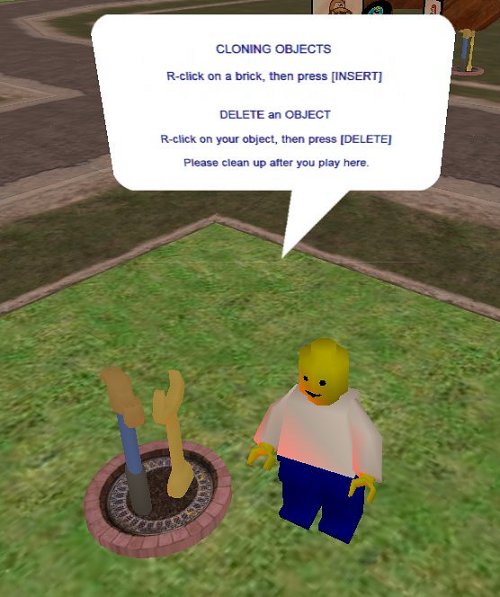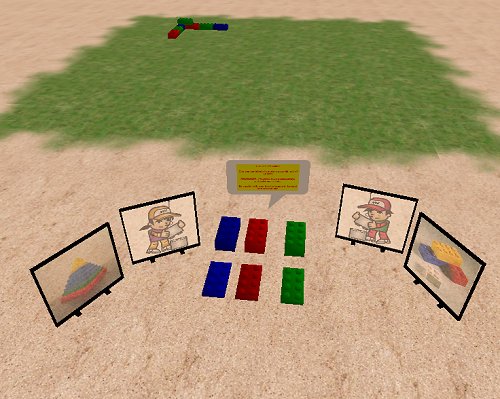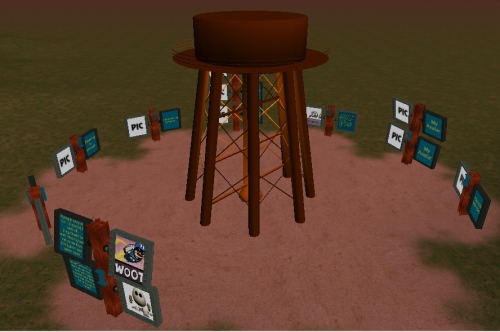iProcrastinate 1.01b
…lol
When I should have been busy marking, and other good teachery things, I found the virtual world a great place to just … do … stuff.
Sure, there is plenty to do – the cybernauts are entering the “build” phase of the investigation, so there is a real need for tutorial areas, exemplar builds and the like.
So I began shackling stuff together, to show how it can be done, tried to think through the process I use when building, and how that would translate for a noob.
The Cybernauts have been in, the Roman Villa and associated ruins are taking shape, we now have a market square, bath house, grand house, other assorted buildings – some are really getting into the spirit of the challenge, others are puddling away in “Sky City” – bottom line it does not matter where they practice to build, so long as they do. I even FILMED a walkaround for your viewing pleasure retrowalkaround
I got a little narky – wondered if, with a little careful scaling and rotating it would be possible to make a familiar building … 20 minutes later:
…a 1/4 scale version of the main concert hall roof structure (I love this place in the real world) – buggered if this does not solve a problem I was wrestling with over on Sci Prime – the roofline of my Observatory will be these familiar sails I think. We shall see.
The Object Catalog is gradually coming together, with a team of patient people popping and screen-grabbing objects for it over on SomaIII, will be seriously hoopy when done:
4 people working at a time, huge job (thousands of objects to index), progress being made, all good.
Noob today, 1337 tomorrow …
So I have begun making a zone specifically for noobs, builder noobs in particular and it struck me how complicated building with any sort of quality actually is.
I figured I should start with a gimmick, so dived into Wings3d (a favorite mesh editor) and sculpted a HAMMER and a SPANNER – nothing says construction to me like tools. I decided they needed to be on a pedestal, rotating and glowing magically, as they do in real life. I am, initially, doing the whole “Lego” thing because nothing quite matches it as a modular metaphor, plus we are dealing with a primary clientèle so I figure I should try to talk to them where they are.
I decided that the tutorial zone should be non-linear, but if you wanted to follow the skills developmentally in a linear fashion that should be possible also – to that end I warp between stations in the order I think makes sense. WARPING is a neato transition trick that is different to teleporting – it is like a fast run to your destination – this way you still get a sense of space and a feeling like you are travelling – I think it is most effective here in the metaphor of a skills journey also.
So, in this sequence, punters click on the rotating and magically glowing toolbox to progress to the next step if they want to discover things sequentially, or walk/fly on their own. I think this is a reasonable way to do this, but am open to suggestions.
In Activeworlds, you need a source object to make a new object … this solves the age old question because you can take a chicken and make an egg, or visa versa, but first you have to CLONE an object from something already there. R-Click is the gateway to editing (including clone, delete and other stuff).
Next I figure you need to know how to move it around. Activeworlds, like Secondlife, lets you steer your object on it’s current plane using arrow keys. Key-presses equate to steps and there are three step sizes (50cm, 5cm and 1cm) achievable using raw arrows, shift+arrows and shift+control+arrow keys. raising and lowering an object is achieved using the number pad +/- buttons (step sizes and modifiers work the same) … there is an interesting rub – you NEED a number pad to be effective in Activeworlds, else you have to resort to reassigning keys that sometimes almost, kind of sort of, nearly work.
Rotating objects gets a little trickier to explain – if the object is in it’s original grid-aligned position, then controlling pitch, rotation and yaw is “relatively” straight forward – using PgUp|PgDn, Home|End and /|* buttons on the NUMBER PAD you rotate the object in x, y or z relative to the directions of the axes for that object. Rotations happen in degrees (15, 1.5 and 0.1 increments using movement modifier keys like moving) so quite precise alignment and swizzling of objects is possible. Pixel perfect is a little more tricksey as, depending on your graphics card’s ability and the client settings, some objects rezz slightly out of alignment, even tho they are not (maybe that is just me being anal, but that erks me – one particular panel in a hallway I tweak every time I walk past it … but I digress).
I am not sure how well my instructions make sense to kids who are still in the concrete operational stage (and are yet to gain the ability to envisage things in 3d), still I guess concise facts are a good thing. I had “Michael12” (a strolling year6 of no fixed address) try them out for me in-world and he said it was cool, so I guess that means it was almost non-gibberish.
Re-sizing objects, like rotating requires a little 3d spatial awareness and I am not at all sure what I am saying makes any sense, yet. I need to mull over this – I think something diagrammatic might work better.
In all, the beginnings of the sculpture park are promising, I think they need little stages and backdrops, so will make them in keeping with the welcome wall I think as it is a simple yet effective way of creating a private space in an otherwise open world – that and the rust goes well with my sculpture so it is all visually continuous.
So … to test how well Cybernauts get the whole basic building block thing, I have created a stacking competition – using iLego, we are going to collaboratively build a pyramid. the bricks stack neatly side by side in whole steps, are 60cm high so stacking them on top of an existing row is manageable … we shall see how it goes. I guess this is one way to measure success.
n00bs, gotta love ’em
… you land on this foreign planet, right, and you are the visitor, so what do you need to know?
That question is an interesting one – in a 3D world there is LOTS that you can know but what do you NEED to know.
context: punters are students years p-7, and their teachers, and some mentors.
I thought that concentrating on CITIZEN RIGHTS was a good starter – privacy, save place to learn etc, all good up-front.
Then come CITIZEN RESPONSIBILITIES – a little more fuzzy, but things like don’t break what is not yours, do not offend, clean up after you etc.
I figure if you place this stuff where they HAVE to walk past, at least initially, there is a chance they might read it – the wording and format … that is the part of the task that is like nailing jelly to a tree.
If I use “sign” objects, then there is a limit to the number of characters I can display, and I have nearly no control over the format (font size, wrapping, text effects), so will need to seek advice higher re visual styling and consistence, and I guess the actual wording. The “picture” object lets me embed an image version of the wording (that takes time, I prepared one earlier) which I think is the right way to go – styling and someone with the actual time to do this right now … umm, help.
I went for an industrial feel – the whole complex is old, corroded and not shiny so I think it fits. It still looks a bit spartan, yet to embellish and clutter, concentrating on the infrastructure first and will busy it up later. I used rusty “I” beams, thought they looked ok and let me expand when I need to, just get out the welder and we are away.
I included the obligatory “work in progress” – in much the same way a website is NEVER complete, I would be astounded if this world ever is finished – people long after I am gone will be adding/modifying/re-working I hope.
I included reference to a “basic orientation” or O-ZONE interestingly clustered around the base of the ozone tank, well I thought it was clever, and began to imagine what are the basic skills required to just drive the world – not building, that will be handled elsewhere, just the beginners guide to Activeworld use.
Moving; talking and more generally communicating; playing with your avatar; manipulating objects; remembering places; and taking pictures were what I first concentrated on – what have I missed?
It needs to be clear, concise, written in a language that can be understood by emerging literacies, it should where possible have companion illustrations, they should be fun, informative, simple but illustrative – all in all, quite a task.
I will have to ask for help I think as I am flat out designing and making the buildings – the level of accompanying documentation and illustration is important and will couch the activities that users involve themselves in when we are in production.
So … HOMEWORK: what do nOObs need to know? How do we tell them? What level of explanation is appropriate as an intro – can the skills be categorised? What sequence? How should they be displayed? All interesting questions dear reader – want to contribute to the discussion?
